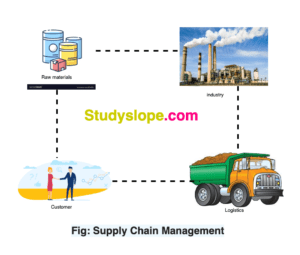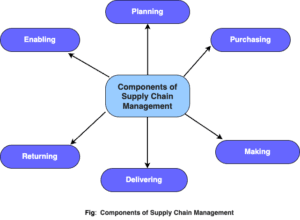Table of Contents
Supply Chain Management Definition
The term “supply chain management” (SCM) refers to the management of the flow of goods and services, which includes all the intermediate processes which transform raw materials into finished products or services that can be delivered to end customers. SCM can be defined as “the management of the flow of goods and services.” Effective supply chain management makes it possible for manufacturers and merchants to reduce costs by cutting back on surplus inventory.
Overview of Supply Chain Management
SCM has been around for a very long time, ever since the very first product or service was made and provided to customers. However, the sophistication of SCM is a product of both the development of technology and the industrialisation of society. Because of this, businesses have been encouraged to improve their production methods to speed up the delivery of their goods and services to consumers. The term “supply chain management” (SCM) refers to the centralised monitoring and administration of the flow of goods and services. This includes all the operations that convert raw materials into finished commodities.

SCM requires unified planning and implementation of processes to maximise efficiency in demand forecasting, procurement, production, inventory management, and logistics (such as storage and transportation), as well as customer service. So, the supply chain is made up of all the tasks that are needed to get these jobs done, from making products to coming up with new ones.
Objectives of Supply Chain Management
The following is a list of the most important strategic goals that SCM has set for itself:
Improves operational efficiency: Effective management of inventory, transportation, and logistics can be hard and requires a strong understanding of the processes involved. This understanding is essential to achieving maximum operational efficiency. When product makers, distributors, and retailers work together to improve the supply chain system, it works better and to its fullest potential.
Transportation and logistics optimisation: In the framework of an independent firm, the company is entrusted with the tasks and responsibilities of ordering, shipping, and transporting the items. On the other hand, the costs tend to be higher in a firm structure like this one because of poor time management and coordination. By ensuring that suppliers, wholesalers, and retailers all adhere to the same standards, SCM makes it possible to optimise and streamline the flow of the processes. The system is being updated so that orders can be done automatically and notifications for other functions can be sent out.
Cost Reduction: One of the important goals of supply chain management is to reduce the operation cost of the company. It pushes down the overall cost of production, procurement, and logistics by creating an optimised supply chain.
Quality improvement: Partners in the supply chain share the crucial goal of offering clients value-added goods or services. Because working together with the middlemen offers quality improvements, As a result, the collaborative and coordinated supply chain establishes a method via which the business and other downstream partners in the supply chain can collect customer feedback.
Establishing Better Coordination: Another objective of Supply Chain Management is to achieve a higher level of coordination amongst the many stakeholders in an organisation. It has been made possible for employees, customers, and vendors to communicate effectively with the organisation through the establishment of a channel. In the event of a crisis, managers can promptly lead their workforce, and employees are able to interact with their supervisors via the channel that has been established.
In addition, clients can access all the information they require by logging onto self-service portals that have been set up as part of the customer support system. It makes it easier for all the stakeholders to share information with one another and contributes to the development of an organisation that has excellent coordination.
Better Distribution:
The objective of Supply Chain Management is to ensure better distribution. It has the potential to maximise the efficiency of the distribution side. The best level of distribution can be reached if the marketer or distributor makes good use of all the tools they have.
Importance of Supply Chain Management
Greater consumer service: The processes of SCM make it possible to improve the level of customer service provided. It makes sure that things move smoothly and at the right time, which helps keep customers coming back if it is done well and followed.
Reduced operational costs: The most significant benefit of supply chain management is the reduction in the costs associated with running a business. The whole cost of procurement, production, and the supply chain can be reduced thanks to SCM operations. As a result, the company’s economic development has been accelerated because of greater profit margins and cash flow. By reorganising the distribution network and reducing the costs associated with maintaining superfluous assets, the best practices for SCM can also reduce the amount of unnecessary use of fixed assets like warehouses and cars.
Societal safety: SCM has an important but largely unrecognised role in society, particularly regarding societal safety. It makes sure that humans will continue to exist by making sure that people have food, water, medical care, and energy in their homes and businesses.
Career Opportunities: Sustainable consumption and production (SCM) also improve the quality of life by creating job opportunities, providing a platform for economic growth, and elevating living standards. Because SCM specialists are responsible for managing and designing the many roles in supply chains, they open a variety of job opportunities.
Components of Supply Chain Management
The following are the Six components of Supply Chain Management:

Planning: To fulfil the requirements of their clients, businesses are obligated to efficiently plan and manage all their available resources. The planning stage of the supply chain process involves developing the layout and agreeing on the metrics to be used to achieve the corporate goals. This step also takes place at the beginning of the process.
Purchasing: Businesses are obliged to compile a list of the suppliers from which they will obtain the necessary raw materials to manufacture their products. After getting the contract with the supplier, several steps are taken to manage the relationship with the supplier.
Making: Supply chain managers are responsible for coordinating and monitoring a variety of activities, including the procurement of inventory, the production of products, quality testing, packing, and the scheduling of deliveries. Businesses look at things like quality, production output, and employee performance to make sure their goods and services are up to par.
Delivering: Also known as logistics, this process involves coordinating customer orders, planning, and scheduling deliveries, consigning cargo, billing customers, and collecting payments. The trail of vehicles is an important part of delivering goods to customers.
Returning: To accept back products that are either excess, faulty, or obsolete, a provider needs a network that is response-oriented and resilient. If the item in question has an error, it must either be fixed or discarded. And if there is an excess of it, it must be brought back to the warehouse to be put up for sale.
Enabling: To perform its functions efficiently, the supply chain needs the support of peripheral services in order to maintain a record of information all along the chain and verify that it complies with regulatory standards. Sales, Quality Control, Product Design, Financial Management, Human Resources, Information Technology, Portfolio Management, and Quality Assurance are all examples of these processes.


2 thoughts on “What is Supply Chain Management?”
Comments are closed.